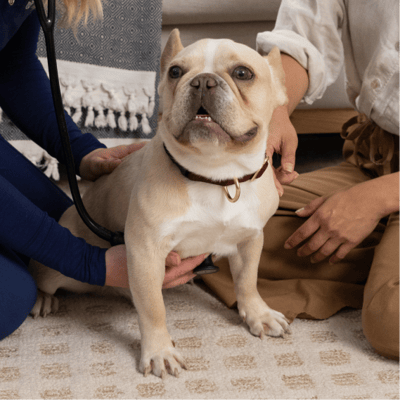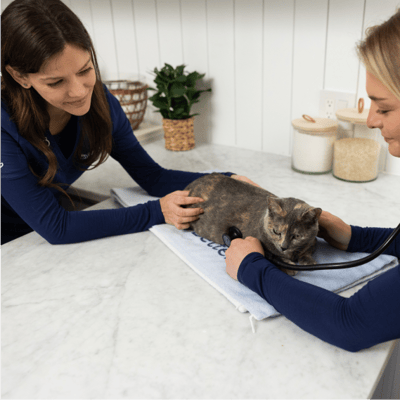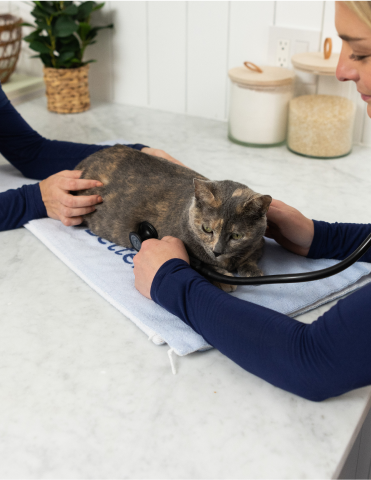
Why BetterVet?
Our mobile veterinarians examine pets in their favorite spot - a comfy couch, a cozy pet bed, or even your lap! See how we work to keep pets relaxed and happy at home.
An important diagnostic tool to assess your pet’s health, an electrocardiogram (ECG or EKG) measures the electrical impulses of the heart and can detect any abnormal rhythms or arrhythmias.
Note: ECG services are available in select locations. Your veterinarian may recommend and perform an ECG during a Sick Visit (for an additional cost). Depending on your location, our veterinarians can perform dog and cat ECGs in your home or the BetterVet vehicle.

Your BetterVet veterinary care team is able to perform dog and cat ECGs, without the need to transport your pet to a traditional veterinary clinic.
As part of our comprehensive wellness service offerings, your veterinarian may recommend an ECG as a proactive health measure.
Our mobile vets spend quality time with each pet and create a personalized treatment plan based on a comprehensive physical exam and diagnostic testing, such as ECG.
Our mobile ECG service brings both convenience and comfort to pet parents by eliminating the need for car rides and clinic visits.
Diagnostic tests such as an ECG provide pet parents with immediate insights into your pet's cardiac health, offering peace of mind about your dog or cat’s well-being.
An ECG provides information about your pet’s cardiac health, such as:
Heart rhythm
Heart rate
Arrhythmias
Atrial or ventricular abnormalities
Certain forms of heart disease
Syncope (fainting) episodes
Pre-anesthetic screening
The ECG process is simple and painless. Our veterinarians will explain the procedure and answer any questions you may have.

Your pet’s ECG will take place during a comprehensive Physical Wellness or Sick Exam, during which your veterinarian will provide a thorough checkup of your pet from nose to tail.

Once your dog or cat is calm and comfortable your veterinarian will perform the following steps:
Apply rubbing alcohol or gel and place the ECG electrodes on your pet’s legs.
Record your pet’s electrical impulses for as short as a minute’s time, up to a few minutes.
After the test, your veterinarian may send the results out to a veterinary cardiologist for interpretation.

Your pet’s ECG report can take up to five business days to interpret, depending on the cardiology service. Your veterinarian will then contact you to discuss the results.

Once your veterinarian has reviewed the results of your pet’s ECG, they will create and communicate with you about a plan for your pet’s care, including any additional appointments, medications, or referrals.

BetterVet have my full confidence with the life of my son Nico Jones. They are THE BEST in their field, in my professional opinion (being in the medical field myself for so long). I have no worries that my Nico is in great hands. How do I know? Because not only is my Nico living the best life he can (his diagnosis is chronic congestive heart failure) but he is ultimately loved by these individuals. They came by for a procedure at. my house and Nico was so comfortable with them that no sedation was required. Dr. Steve and Chris work incredibly synchronized together and that is key in my eyes. When I spoke to a pet cardiologist and was giving a little history of why Nico was going to visit them, they stated, "Nico is receiving the right medications. His treatment plan is what we would have done and would recommend". That gave me such a peace of mind!!!! Thank you two! You are heaven sent!
An ECG is performed within the in-home comprehensive Wellness or Sick Exam which typically lasts about 30 to 45 minutes. The ECG test by itself lasts about one to three minutes but can vary if additional recordings are needed.
Unless otherwise specified by your veterinarian, you do not need to do anything special to prepare your pet for an ECG. If your pet becomes highly anxious during their physical exam, you may want to discuss whether pre-visit medication may be in your pet’s best interest.
Your pet’s ECG will be performed during an in-home Sick Physical Exam. We have flexible appointment times as well as same-day and next-day availability in many locations. Contact your BetterVet veterinarian to request an ECG during your pet’s exam.
Whether your pet’s ECG procedure is covered by your pet insurance will depend on the details of your individual policy. We will be happy to provide you with any records or assistance you need to submit your claim to your insurance company. Please let your veterinarian know what you will need at the time of your visit.
If your pet’s ECG reveals an issue with their cardiac health, your veterinarian will work with you to make the best plan for your pet.
Your pet should not need any special care following an ECG exam, but if additional steps are required, they will make sure they are fully communicated.
All of our veterinarians are board-certified in small animal medicine and experienced and qualified to perform an ECG.

Skip the traffic by booking a mobile vet visit with one of our trusted veterinarians. We bring full-service vet care to you!